Organizational Communication: Implementing Formal Networks
VerifiedAdded on 2023/06/15
|8
|1420
|320
Essay
AI Summary
This essay delves into the critical aspects of organizational communication, focusing on formal and informal communication networks. It begins by defining organizational communication and highlighting the differences between formal and informal communication, with formal communication involving structured channels like emails and notices, and informal communication occurring outside formal structures through word-of-mouth. The essay then explores different types of communication networks within both formal and informal settings, such as single-chain, wheel, and free-flow networks in formal communication, and gossip and cluster networks in informal communication. The author expresses particular interest in these various communication networks and emphasizes the importance of implementing formal communication networks effectively to ensure smooth information flow within an organization. The essay concludes by outlining steps to implement downward and upward communication channels, emphasizing the need for feedback and smooth information transmission, and highlighting the role of management in establishing formal channels while acknowledging the organic nature of informal networks. Desklib offers a variety of solved assignments and study tools for students.
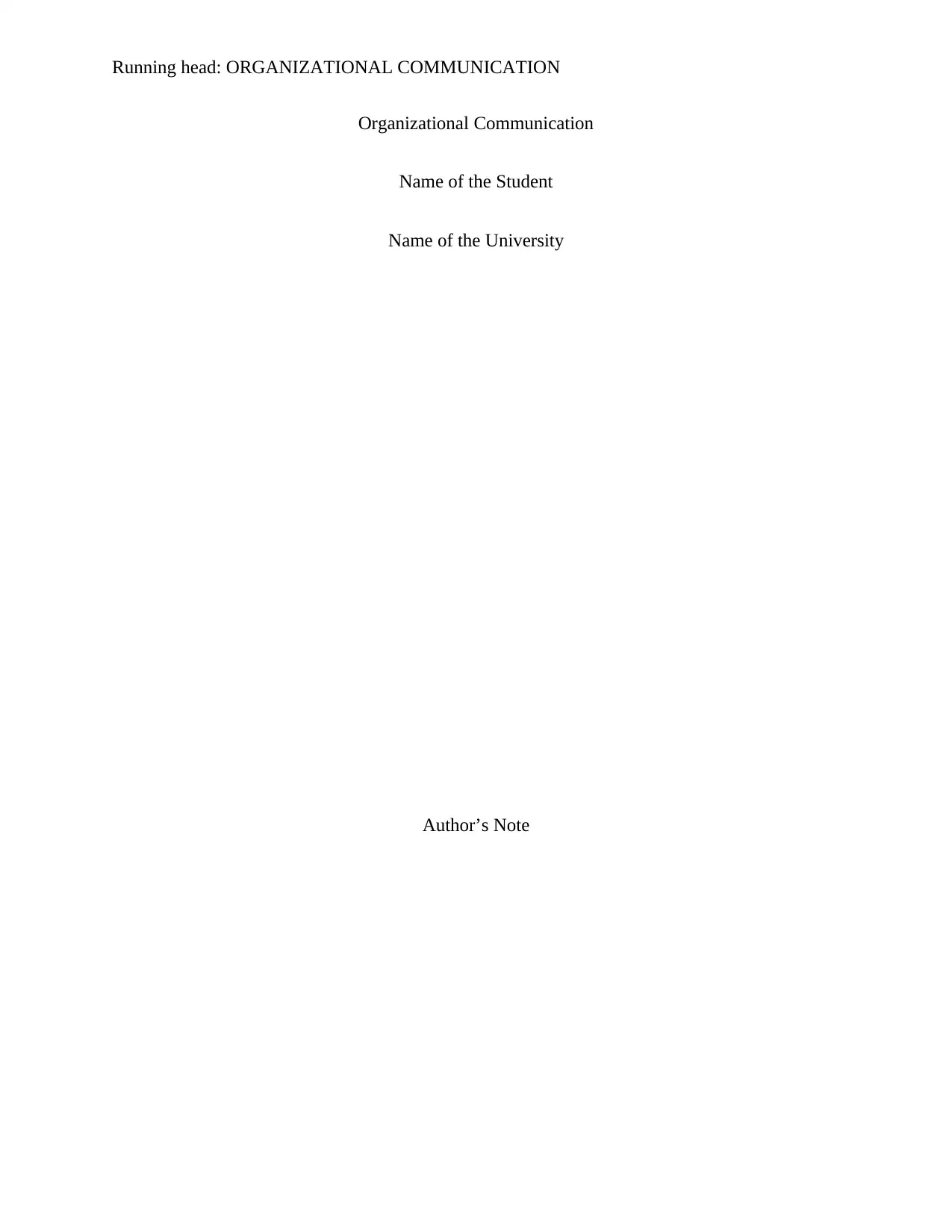
Running head: ORGANIZATIONAL COMMUNICATION
Organizational Communication
Name of the Student
Name of the University
Author’s Note
Organizational Communication
Name of the Student
Name of the University
Author’s Note
Paraphrase This Document
Need a fresh take? Get an instant paraphrase of this document with our AI Paraphraser
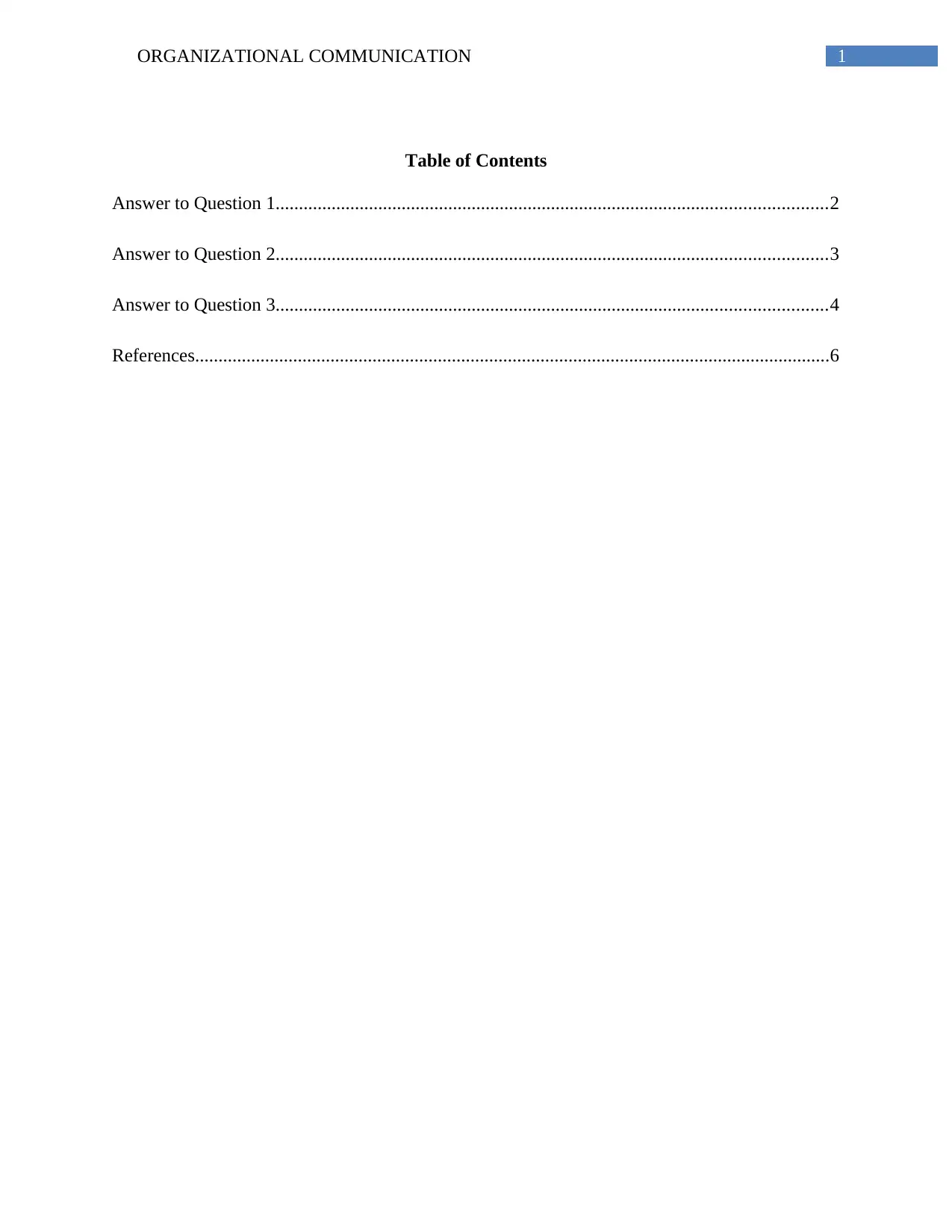
1ORGANIZATIONAL COMMUNICATION
Table of Contents
Answer to Question 1......................................................................................................................2
Answer to Question 2......................................................................................................................3
Answer to Question 3......................................................................................................................4
References........................................................................................................................................6
Table of Contents
Answer to Question 1......................................................................................................................2
Answer to Question 2......................................................................................................................3
Answer to Question 3......................................................................................................................4
References........................................................................................................................................6
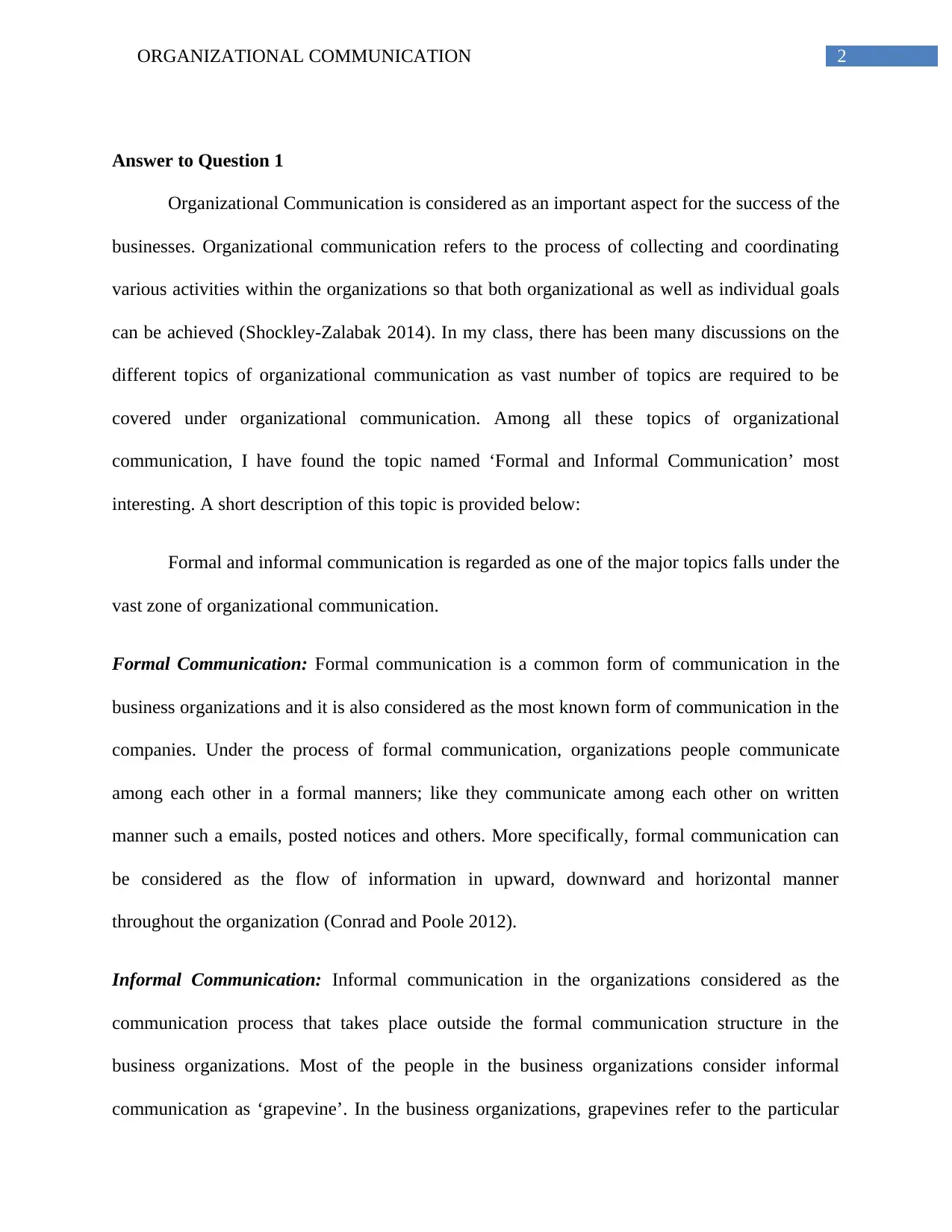
2ORGANIZATIONAL COMMUNICATION
Answer to Question 1
Organizational Communication is considered as an important aspect for the success of the
businesses. Organizational communication refers to the process of collecting and coordinating
various activities within the organizations so that both organizational as well as individual goals
can be achieved (Shockley-Zalabak 2014). In my class, there has been many discussions on the
different topics of organizational communication as vast number of topics are required to be
covered under organizational communication. Among all these topics of organizational
communication, I have found the topic named ‘Formal and Informal Communication’ most
interesting. A short description of this topic is provided below:
Formal and informal communication is regarded as one of the major topics falls under the
vast zone of organizational communication.
Formal Communication: Formal communication is a common form of communication in the
business organizations and it is also considered as the most known form of communication in the
companies. Under the process of formal communication, organizations people communicate
among each other in a formal manners; like they communicate among each other on written
manner such a emails, posted notices and others. More specifically, formal communication can
be considered as the flow of information in upward, downward and horizontal manner
throughout the organization (Conrad and Poole 2012).
Informal Communication: Informal communication in the organizations considered as the
communication process that takes place outside the formal communication structure in the
business organizations. Most of the people in the business organizations consider informal
communication as ‘grapevine’. In the business organizations, grapevines refer to the particular
Answer to Question 1
Organizational Communication is considered as an important aspect for the success of the
businesses. Organizational communication refers to the process of collecting and coordinating
various activities within the organizations so that both organizational as well as individual goals
can be achieved (Shockley-Zalabak 2014). In my class, there has been many discussions on the
different topics of organizational communication as vast number of topics are required to be
covered under organizational communication. Among all these topics of organizational
communication, I have found the topic named ‘Formal and Informal Communication’ most
interesting. A short description of this topic is provided below:
Formal and informal communication is regarded as one of the major topics falls under the
vast zone of organizational communication.
Formal Communication: Formal communication is a common form of communication in the
business organizations and it is also considered as the most known form of communication in the
companies. Under the process of formal communication, organizations people communicate
among each other in a formal manners; like they communicate among each other on written
manner such a emails, posted notices and others. More specifically, formal communication can
be considered as the flow of information in upward, downward and horizontal manner
throughout the organization (Conrad and Poole 2012).
Informal Communication: Informal communication in the organizations considered as the
communication process that takes place outside the formal communication structure in the
business organizations. Most of the people in the business organizations consider informal
communication as ‘grapevine’. In the business organizations, grapevines refer to the particular
⊘ This is a preview!⊘
Do you want full access?
Subscribe today to unlock all pages.

Trusted by 1+ million students worldwide
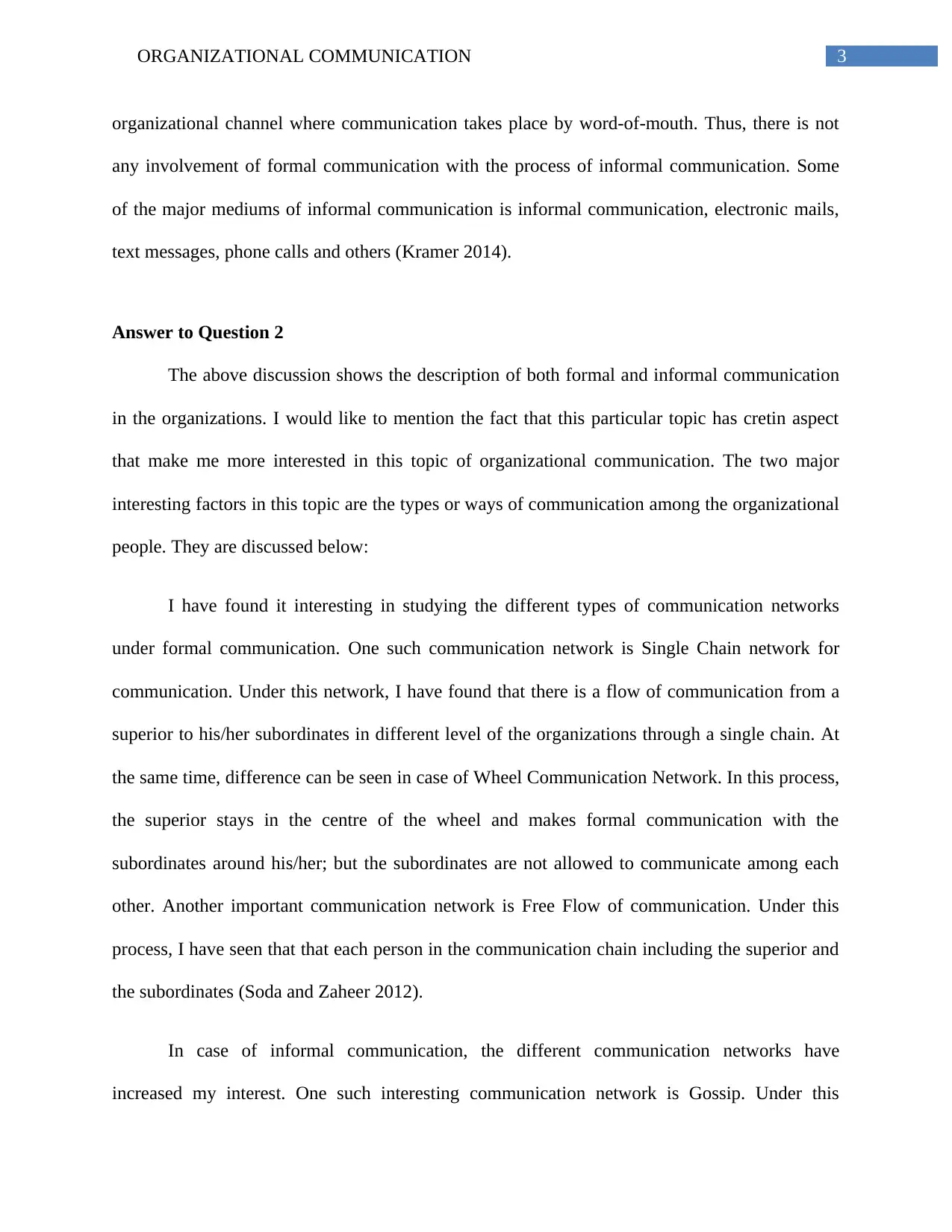
3ORGANIZATIONAL COMMUNICATION
organizational channel where communication takes place by word-of-mouth. Thus, there is not
any involvement of formal communication with the process of informal communication. Some
of the major mediums of informal communication is informal communication, electronic mails,
text messages, phone calls and others (Kramer 2014).
Answer to Question 2
The above discussion shows the description of both formal and informal communication
in the organizations. I would like to mention the fact that this particular topic has cretin aspect
that make me more interested in this topic of organizational communication. The two major
interesting factors in this topic are the types or ways of communication among the organizational
people. They are discussed below:
I have found it interesting in studying the different types of communication networks
under formal communication. One such communication network is Single Chain network for
communication. Under this network, I have found that there is a flow of communication from a
superior to his/her subordinates in different level of the organizations through a single chain. At
the same time, difference can be seen in case of Wheel Communication Network. In this process,
the superior stays in the centre of the wheel and makes formal communication with the
subordinates around his/her; but the subordinates are not allowed to communicate among each
other. Another important communication network is Free Flow of communication. Under this
process, I have seen that that each person in the communication chain including the superior and
the subordinates (Soda and Zaheer 2012).
In case of informal communication, the different communication networks have
increased my interest. One such interesting communication network is Gossip. Under this
organizational channel where communication takes place by word-of-mouth. Thus, there is not
any involvement of formal communication with the process of informal communication. Some
of the major mediums of informal communication is informal communication, electronic mails,
text messages, phone calls and others (Kramer 2014).
Answer to Question 2
The above discussion shows the description of both formal and informal communication
in the organizations. I would like to mention the fact that this particular topic has cretin aspect
that make me more interested in this topic of organizational communication. The two major
interesting factors in this topic are the types or ways of communication among the organizational
people. They are discussed below:
I have found it interesting in studying the different types of communication networks
under formal communication. One such communication network is Single Chain network for
communication. Under this network, I have found that there is a flow of communication from a
superior to his/her subordinates in different level of the organizations through a single chain. At
the same time, difference can be seen in case of Wheel Communication Network. In this process,
the superior stays in the centre of the wheel and makes formal communication with the
subordinates around his/her; but the subordinates are not allowed to communicate among each
other. Another important communication network is Free Flow of communication. Under this
process, I have seen that that each person in the communication chain including the superior and
the subordinates (Soda and Zaheer 2012).
In case of informal communication, the different communication networks have
increased my interest. One such interesting communication network is Gossip. Under this
Paraphrase This Document
Need a fresh take? Get an instant paraphrase of this document with our AI Paraphraser
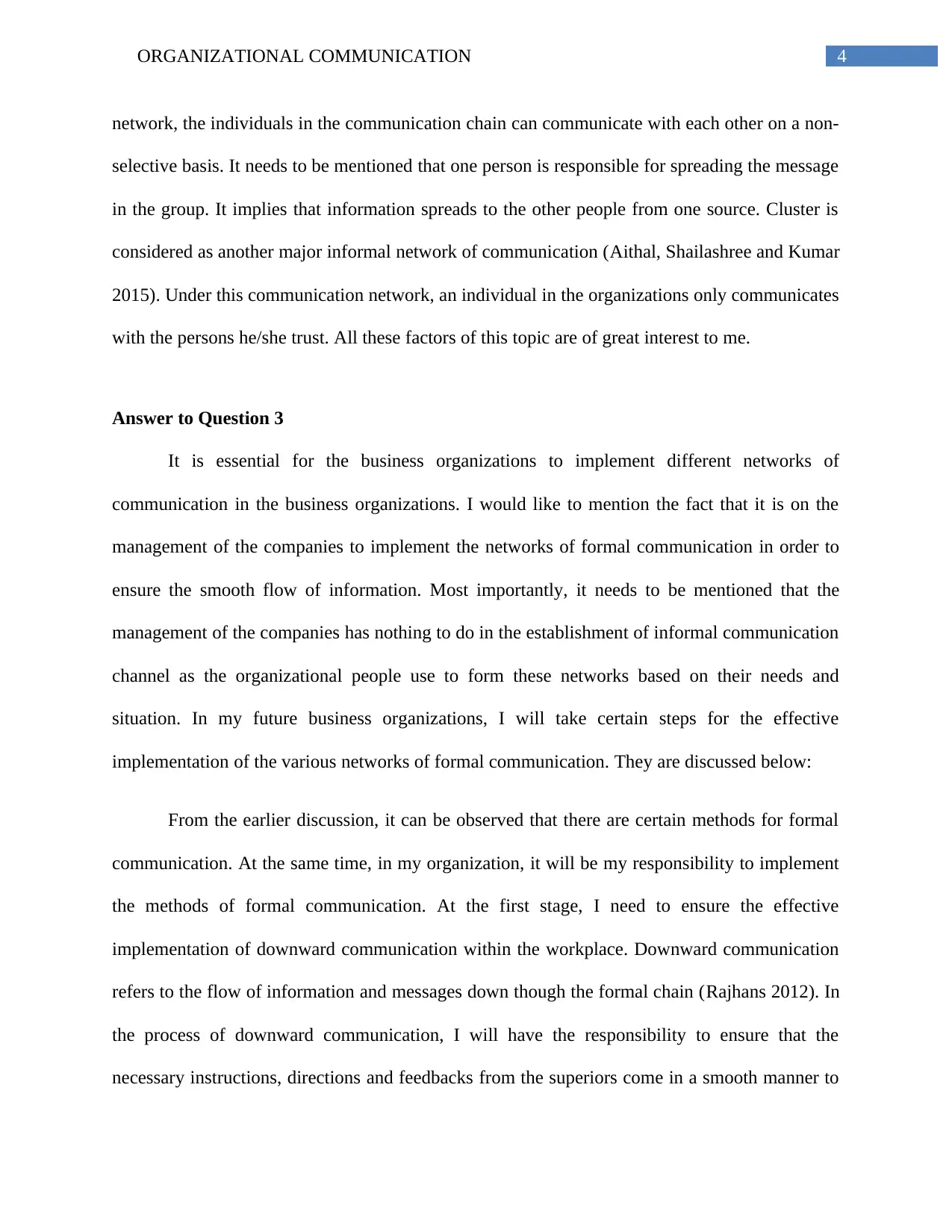
4ORGANIZATIONAL COMMUNICATION
network, the individuals in the communication chain can communicate with each other on a non-
selective basis. It needs to be mentioned that one person is responsible for spreading the message
in the group. It implies that information spreads to the other people from one source. Cluster is
considered as another major informal network of communication (Aithal, Shailashree and Kumar
2015). Under this communication network, an individual in the organizations only communicates
with the persons he/she trust. All these factors of this topic are of great interest to me.
Answer to Question 3
It is essential for the business organizations to implement different networks of
communication in the business organizations. I would like to mention the fact that it is on the
management of the companies to implement the networks of formal communication in order to
ensure the smooth flow of information. Most importantly, it needs to be mentioned that the
management of the companies has nothing to do in the establishment of informal communication
channel as the organizational people use to form these networks based on their needs and
situation. In my future business organizations, I will take certain steps for the effective
implementation of the various networks of formal communication. They are discussed below:
From the earlier discussion, it can be observed that there are certain methods for formal
communication. At the same time, in my organization, it will be my responsibility to implement
the methods of formal communication. At the first stage, I need to ensure the effective
implementation of downward communication within the workplace. Downward communication
refers to the flow of information and messages down though the formal chain (Rajhans 2012). In
the process of downward communication, I will have the responsibility to ensure that the
necessary instructions, directions and feedbacks from the superiors come in a smooth manner to
network, the individuals in the communication chain can communicate with each other on a non-
selective basis. It needs to be mentioned that one person is responsible for spreading the message
in the group. It implies that information spreads to the other people from one source. Cluster is
considered as another major informal network of communication (Aithal, Shailashree and Kumar
2015). Under this communication network, an individual in the organizations only communicates
with the persons he/she trust. All these factors of this topic are of great interest to me.
Answer to Question 3
It is essential for the business organizations to implement different networks of
communication in the business organizations. I would like to mention the fact that it is on the
management of the companies to implement the networks of formal communication in order to
ensure the smooth flow of information. Most importantly, it needs to be mentioned that the
management of the companies has nothing to do in the establishment of informal communication
channel as the organizational people use to form these networks based on their needs and
situation. In my future business organizations, I will take certain steps for the effective
implementation of the various networks of formal communication. They are discussed below:
From the earlier discussion, it can be observed that there are certain methods for formal
communication. At the same time, in my organization, it will be my responsibility to implement
the methods of formal communication. At the first stage, I need to ensure the effective
implementation of downward communication within the workplace. Downward communication
refers to the flow of information and messages down though the formal chain (Rajhans 2012). In
the process of downward communication, I will have the responsibility to ensure that the
necessary instructions, directions and feedbacks from the superiors come in a smooth manner to
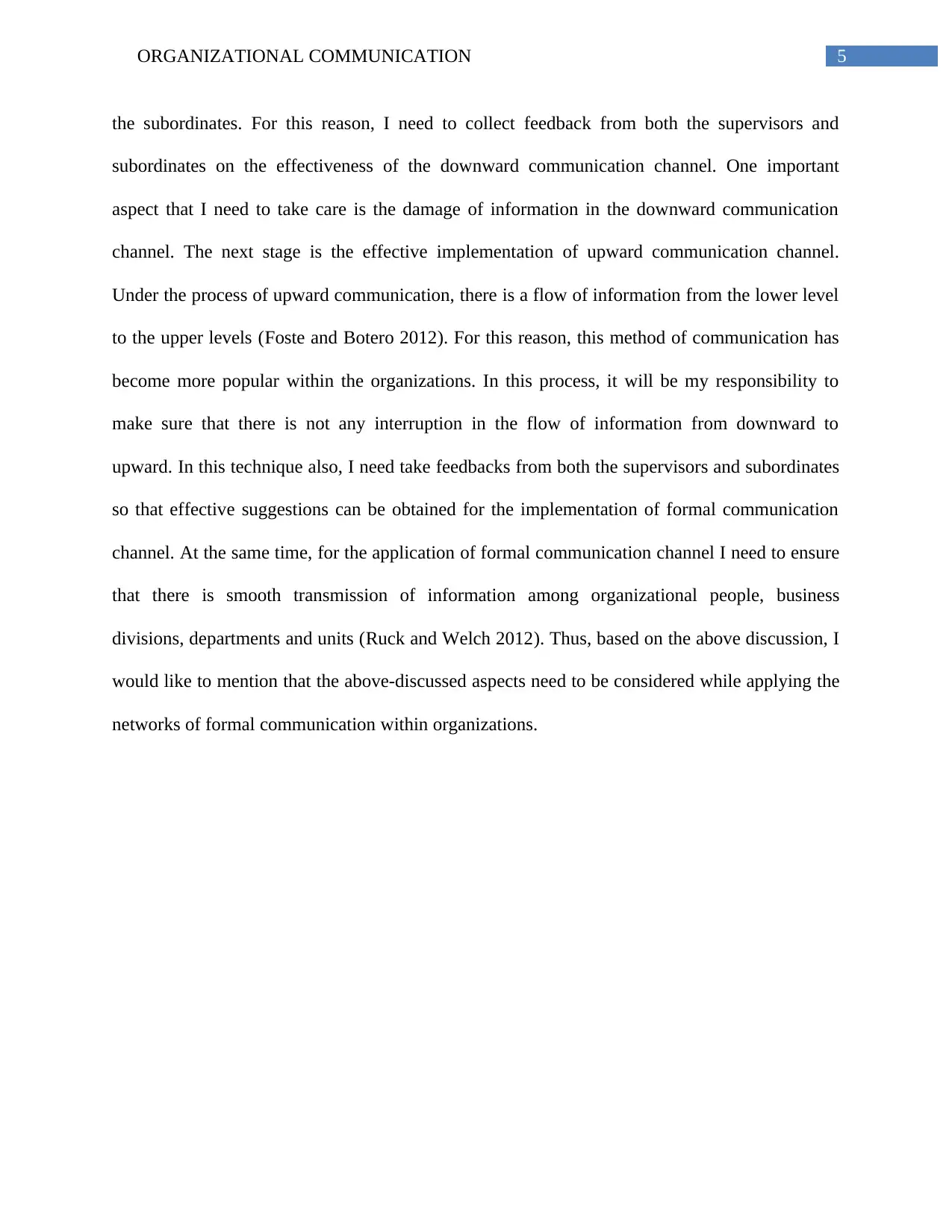
5ORGANIZATIONAL COMMUNICATION
the subordinates. For this reason, I need to collect feedback from both the supervisors and
subordinates on the effectiveness of the downward communication channel. One important
aspect that I need to take care is the damage of information in the downward communication
channel. The next stage is the effective implementation of upward communication channel.
Under the process of upward communication, there is a flow of information from the lower level
to the upper levels (Foste and Botero 2012). For this reason, this method of communication has
become more popular within the organizations. In this process, it will be my responsibility to
make sure that there is not any interruption in the flow of information from downward to
upward. In this technique also, I need take feedbacks from both the supervisors and subordinates
so that effective suggestions can be obtained for the implementation of formal communication
channel. At the same time, for the application of formal communication channel I need to ensure
that there is smooth transmission of information among organizational people, business
divisions, departments and units (Ruck and Welch 2012). Thus, based on the above discussion, I
would like to mention that the above-discussed aspects need to be considered while applying the
networks of formal communication within organizations.
the subordinates. For this reason, I need to collect feedback from both the supervisors and
subordinates on the effectiveness of the downward communication channel. One important
aspect that I need to take care is the damage of information in the downward communication
channel. The next stage is the effective implementation of upward communication channel.
Under the process of upward communication, there is a flow of information from the lower level
to the upper levels (Foste and Botero 2012). For this reason, this method of communication has
become more popular within the organizations. In this process, it will be my responsibility to
make sure that there is not any interruption in the flow of information from downward to
upward. In this technique also, I need take feedbacks from both the supervisors and subordinates
so that effective suggestions can be obtained for the implementation of formal communication
channel. At the same time, for the application of formal communication channel I need to ensure
that there is smooth transmission of information among organizational people, business
divisions, departments and units (Ruck and Welch 2012). Thus, based on the above discussion, I
would like to mention that the above-discussed aspects need to be considered while applying the
networks of formal communication within organizations.
⊘ This is a preview!⊘
Do you want full access?
Subscribe today to unlock all pages.

Trusted by 1+ million students worldwide
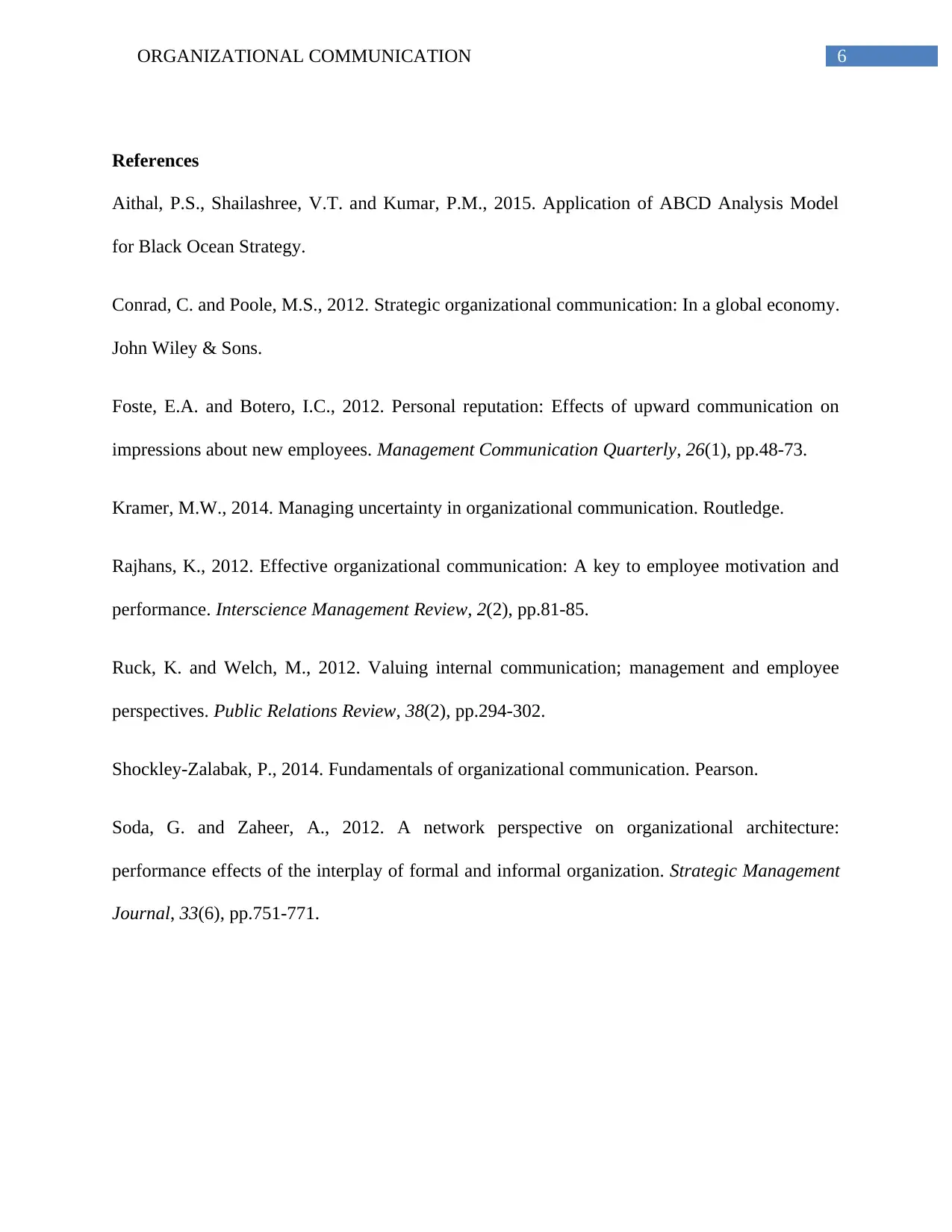
6ORGANIZATIONAL COMMUNICATION
References
Aithal, P.S., Shailashree, V.T. and Kumar, P.M., 2015. Application of ABCD Analysis Model
for Black Ocean Strategy.
Conrad, C. and Poole, M.S., 2012. Strategic organizational communication: In a global economy.
John Wiley & Sons.
Foste, E.A. and Botero, I.C., 2012. Personal reputation: Effects of upward communication on
impressions about new employees. Management Communication Quarterly, 26(1), pp.48-73.
Kramer, M.W., 2014. Managing uncertainty in organizational communication. Routledge.
Rajhans, K., 2012. Effective organizational communication: A key to employee motivation and
performance. Interscience Management Review, 2(2), pp.81-85.
Ruck, K. and Welch, M., 2012. Valuing internal communication; management and employee
perspectives. Public Relations Review, 38(2), pp.294-302.
Shockley-Zalabak, P., 2014. Fundamentals of organizational communication. Pearson.
Soda, G. and Zaheer, A., 2012. A network perspective on organizational architecture:
performance effects of the interplay of formal and informal organization. Strategic Management
Journal, 33(6), pp.751-771.
References
Aithal, P.S., Shailashree, V.T. and Kumar, P.M., 2015. Application of ABCD Analysis Model
for Black Ocean Strategy.
Conrad, C. and Poole, M.S., 2012. Strategic organizational communication: In a global economy.
John Wiley & Sons.
Foste, E.A. and Botero, I.C., 2012. Personal reputation: Effects of upward communication on
impressions about new employees. Management Communication Quarterly, 26(1), pp.48-73.
Kramer, M.W., 2014. Managing uncertainty in organizational communication. Routledge.
Rajhans, K., 2012. Effective organizational communication: A key to employee motivation and
performance. Interscience Management Review, 2(2), pp.81-85.
Ruck, K. and Welch, M., 2012. Valuing internal communication; management and employee
perspectives. Public Relations Review, 38(2), pp.294-302.
Shockley-Zalabak, P., 2014. Fundamentals of organizational communication. Pearson.
Soda, G. and Zaheer, A., 2012. A network perspective on organizational architecture:
performance effects of the interplay of formal and informal organization. Strategic Management
Journal, 33(6), pp.751-771.
Paraphrase This Document
Need a fresh take? Get an instant paraphrase of this document with our AI Paraphraser

7ORGANIZATIONAL COMMUNICATION
1 out of 8
Related Documents
Your All-in-One AI-Powered Toolkit for Academic Success.
+13062052269
info@desklib.com
Available 24*7 on WhatsApp / Email
![[object Object]](/_next/static/media/star-bottom.7253800d.svg)
Unlock your academic potential
Copyright © 2020–2025 A2Z Services. All Rights Reserved. Developed and managed by ZUCOL.




